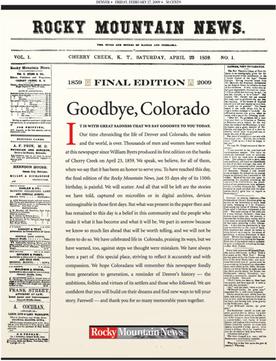
Newsprint is a low-cost, non-archival paper consisting mainly of wood pulp and most commonly used to print newspapers and other publications and advertising material. Invented in 1844 by Charles Fenerty of Nova Scotia, Canada, it usually has an off white cast and distinctive feel. It is designed for use in printing presses that employ a long web of paper, rather than individual sheets of paper.
Benchmarking is the practice of comparing business processes and performance metrics to industry bests and best practices from other companies. Dimensions typically measured are quality, time and cost.

Sports journalism is a form of writing that reports on matters pertaining to sporting topics and competitions. Sports journalism has its roots in coverage of horse racing and boxing in the early 1800s, mainly targeted towards elites, and into the 1900s transitioned into an integral part of the news business with newspapers having dedicated sports sections. The increased popularity of sports amongst the middle and lower class led to the more coverage of sports content in publications. The appetite for sports resulted in sports-only media such as Sports Illustrated and ESPN. There are many different forms of sports journalism, ranging from play-by-play and game recaps to analysis and investigative journalism on important developments in the sport. Technology and the internet age has massively changed the sports journalism space as it is struggling with the same problems that the broader category of print journalism is struggling with, mainly not being able to cover costs due to falling subscriptions. New forms of internet blogging and tweeting in the current millennium have pushed the boundaries of sports journalism.
Affiliate marketing is a marketing arrangement in which affiliates receive a commission for each visit, signup or sale they generate for a merchant. This arrangement allows businesses to outsource part of the sales process. It is a form of performance-based marketing where the commission acts as an incentive for the affiliate; this commission is usually a percentage of the price of the product being sold, but can also be a flat rate per referral.
The Underground Press Syndicate (UPS), later known as the Alternative Press Syndicate (APS), was a network of countercultural newspapers and magazines that operated from 1966 into the late 1970s. As it evolved, the Underground Press Syndicate created an Underground Press Service, and later its own magazine.
Online advertising, also known as online marketing, Internet advertising, digital advertising or web advertising, is a form of marketing and advertising that uses the Internet to promote products and services to audiences and platform users. Online advertising includes email marketing, search engine marketing (SEM), social media marketing, many types of display advertising, and mobile advertising. Advertisements are increasingly being delivered via automated software systems operating across multiple websites, media services and platforms, known as programmatic advertising.

The Calgary Herald is a daily newspaper published in Calgary, Alberta, Canada. Publication began in 1883 as The Calgary Herald, Mining and Ranche Advocate, and General Advertiser. It is owned by the Postmedia Network.
Cost per mille (CPM), also called cost per thousand (CPT), is a commonly-used measurement in advertising. It is the cost an advertiser pays for one thousand views or impressions of an advertisement. Radio, television, newspaper, magazine, out-of-home advertising, and online advertising can be purchased on the basis of exposing the ad to one thousand viewers or listeners. It is used in marketing as a benchmarking metric to calculate the relative cost of an advertising campaign or an ad message in a given medium.

The Rocky Mountain News was a daily newspaper published in Denver, Colorado, from April 23, 1859, until February 27, 2009. It was owned by the E. W. Scripps Company from 1926 until its closing. As of March 2006, the Monday–Friday circulation was 255,427. From the 1940s until 2009, the newspaper was printed in a tabloid format.
Revenue sharing is the distribution of revenue, the total amount of income generated by the sale of goods and services among the stakeholders or contributors. It should not be confused with profit shares, in which scheme only the profit is shared, i.e., the revenue left over after costs have been removed, nor with stock shares, which may be bought and sold and whose value may fluctuate.

The Conference Board, Inc. is a 501(c)(3) non-profit business membership and research organization. It counts over 1,000 public and private corporations and other organizations as members, encompassing 60 countries.

The UCSDGuardian is a student-operated newspaper at the University of California, San Diego. Originally named the Triton Times, it is published once a week during the regular academic year, usually Mondays. Although The Guardian is officially a university department, it is funded solely by advertising. Unlike many college newspapers, The Guardian has no faculty advisor and is not formally tied to any academic program.
The News Media Alliance is a trade association representing approximately 2,000 news media organizations in the United States and in Canada. Member newspapers represented by the Alliance include large daily papers, non-daily and small-market publications, and digital and multiplatform products. The organization has organized and hosted mediaXchange, the newspaper industry's annual conference.
Harry Henry was one of Britain's market research pioneers whose contributions to its acceptance and understanding won him an international reputation. He was the last survivor of the 23 founders of the Market Research Society (MRS), which he helped establish in 1947, and which now has 8,000 members in 50 countries. He married Mary Anstey, daughter of Vera Anstey, in 1938. She died in 1989, a year after they had celebrated their golden wedding anniversary.

Timothy M. Armstrong is an American business executive. He was formerly the CEO of Oath Inc., then a subsidiary of Verizon Communications that served as the umbrella company of its digital content subdivisions, including AOL and Yahoo!. Previously, he was the CEO of AOL Inc. from 2009 until its purchase by Verizon in 2015.

The decline of newspapers in the 21st century is region dependent. Data supports that, in the U.S. and Europe, popularity and sales are wavering. In these regions, industry is facing slumping ad sales, the loss of much classified advertising, and precipitous drops in circulation. The U.S. saw the loss of an average of two newspapers per week between late 2019 and May 2022, leaving an estimated 70 million people in places that are already news deserts and areas that are in high risk of becoming so. Prior to that steep decline, newspapers' weekday circulation had fallen 7% and Sunday circulation 4% in the United States, their greatest declines since 2010. If the trend continues, a third of newspapers will be lost by 2025, according to a 2022 study published by Northwestern University.

A newspaper is a periodical publication containing written information about current events and is often typed in black ink with a white or gray background. Newspapers can cover a wide variety of fields such as politics, business, sports, art, and science. They often include materials such as opinion columns, weather forecasts, reviews of local services, obituaries, birth notices, crosswords, editorial cartoons, comic strips, and advice columns.

BusinessWorld is a business newspaper in the Philippines with a nationwide circulation of more than 117,000. Founded in 1967 as Business Day, it is Southeast Asia's first daily business newspaper.
Frank A. Blethen is an American executive who is the publisher of The Seattle Times and chief executive officer (CEO) of The Seattle Times Company, based in Seattle, Washington, United States. He is a fourth-generation member of the Blethen family, which has owned the newspaper since 1896, and took over as publisher in 1985. He also served as publisher of the Walla Walla Union-Bulletin, a newspaper owned by the company, in the 1970’s. During his tenure as publisher, the family's control of the newspaper declined, along with the profitability of the newspaper industry in general. The newspaper entered into a joint operating agreement with its rival Seattle Post-Intelligencer that lasted until that newspaper ceased printing in 2009.

The COVID-19 pandemic has strongly impacted the journalism industry and affected journalists' work. Many local newspapers have been severely affected by losses in advertising revenues from COVID-19; journalists have been laid off, and some publications have folded. Many newspapers with paywalls lowered them for some or all of their COVID-19 coverage. The pandemic was characterized as a potential "extinction event" for journalism as hundreds of news outlets closed and journalists were laid off around the world, advertising budgets were slashed, and many were forced to rethink how to do their jobs amid restrictions on movement and limited access to information or public officials. Journalists and media organizations have had to address new challenges, including figuring out how to do their jobs safely and how to navigate increased repression and censorship brought on by the response to the pandemic, with freelancers facing additional difficulties in countries where press cards or official designations limit who can be considered a journalist.










